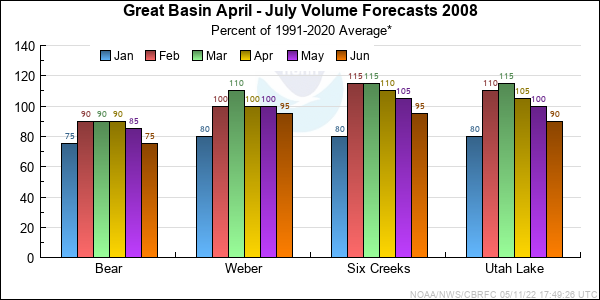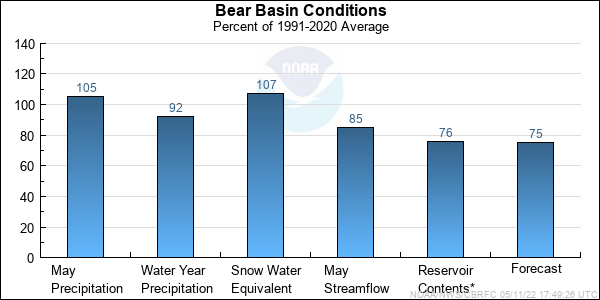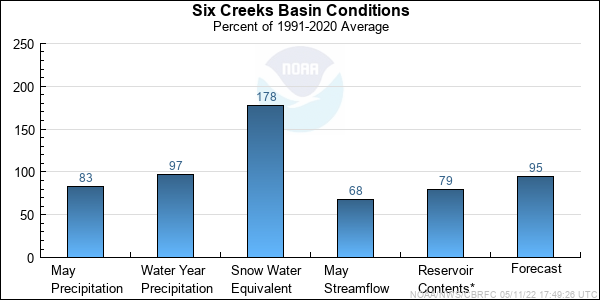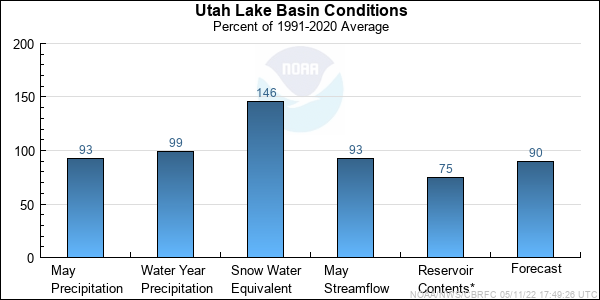
NOAA, National Weather Service
Colorado Basin River Forecast Center
Salt Lake City, Utah
www.cbrfc.noaa.gov
 | Prepared by Brent Bernard NOAA, National Weather Service Colorado Basin River Forecast Center Salt Lake City, Utah www.cbrfc.noaa.gov |





| Forecast Period | 90% Exceedance Volume | 50% Exceedance Volume | Percent Average | 10% Exceedance Volume | |
| Bear | |||||
| Utah | April-July | 90 | 107 | 95 | 139 |
| June-July | 41 | 67 | 96 | 85 | |
| Woodruff Narrows Res | April-July | 61 | 117 | 78 | 167 |
| June-July | 7.7 | 55 | 51 | 96 | |
| Big Ck | |||||
| Randolph, Nr | April-July | 1.8 | 2.9 | 59 | 5.4 |
| June-July | 0.65 | 1.7 | 75 | 4.8 | |
| Smiths Fork | |||||
| Border, Nr | April-July | 56 | 77 | 75 | 94 |
| June-July | 33 | 52 | 85 | 65 | |
| Bear | |||||
| Montpelier, Nr, Stewart Dam, Blo | April-July | 60 | 80 | 34 | 175 |
| June-July | 20 | 52 | 47 | 82 | |
| Logan | |||||
| Logan, Nr, State Dam, Abv | April-July | 75 | 97 | 77 | 110 |
| June-July | 39 | 65 | 93 | 75 | |
| Blacksmith Fork | |||||
| Hyrum, Nr, Upnl Dam, Abv | April-July | 14.8 | 35 | 73 | 53 |
| June-July | 6.3 | 15 | 75 | 22 |
| Forecast Period | 90% Exceedance Volume | 50% Exceedance Volume | Percent Average | 10% Exceedance Volume | |
| Weber | |||||
| Oakley, Nr | April-July | 87 | 111 | 90 | 129 |
| June-July | 43 | 69 | 97 | 89 | |
| Rockport Res, Wanship, Nr | April-July | 78 | 117 | 87 | 146 |
| June-July | 35 | 70 | 97 | 95 | |
| Coalville, Nr | April-July | 85 | 113 | 82 | 140 |
| June-July | 57 | 60 | 86 | 63 | |
| Chalk Ck | |||||
| Coalville | April-July | 26 | 44 | 98 | 62 |
| June-July | 9.9 | 22 | 128 | 34 | |
| Weber | |||||
| Echo Res, Echo, At | April-July | 127 | 172 | 96 | 215 |
| June-July | 37 | 73 | 88 | 109 | |
| Lost Ck | |||||
| Lost Ck Res, Croydon, Nr | April-July | 6.6 | 13 | 74 | 19.4 |
| June-July | 1.7 | 3.3 | 72 | 5.9 | |
| East Canyon Ck | |||||
| East Canyon Res, Morgan, Nr | April-July | 22 | 33 | 106 | 44 |
| June-July | 5.6 | 10 | 106 | 14 | |
| Weber | |||||
| Gateway | April-July | 205 | 315 | 89 | 425 |
| June-July | 66 | 130 | 103 | 194 | |
| Sf Ogden | |||||
| Huntsville, Nr | April-July | 38 | 53 | 83 | 68 |
| June-July | 6.1 | 14 | 86 | 22 | |
| Ogden | |||||
| Pineview Res, Ogden, Nr | April-July | 73 | 110 | 83 | 147 |
| June-July | 4.3 | 25 | 83 | 46 | |
| Wheeler Ck | |||||
| Huntsville, Nr | April-July | 4.6 | 6.2 | 98 | 7.8 |
| June-July | 0.9 | 3 | 143 | 5 |
| Forecast Period | 90% Exceedance Volume | 50% Exceedance Volume | Percent Average | 10% Exceedance Volume | |
| Little Cottonwood Ck | |||||
| Salt Lake City, Nr | April-July | 27 | 36 | 90 | 45 |
| June-July | 22 | 28 | 108 | 34 | |
| Big Cottonwood Ck | |||||
| Salt Lake City, Nr | April-July | 19 | 33 | 87 | 48 |
| June-July | 14.4 | 21 | 100 | 28 | |
| Mill Ck | |||||
| Salt Lake City, Nr | April-July | 3.5 | 5.4 | 77 | 7.3 |
| June-July | 2.2 | 3.3 | 92 | 4.4 | |
| Dell Fk | |||||
| Little Dell Res | April-July | 4 | 5.4 | 79 | 6.9 |
| June-July | 0.31 | 1.6 | 95 | 2.9 | |
| Parleys Ck | |||||
| Salt Lake City, Nr | April-July | 5 | 10.2 | 61 | 15.4 |
| June-July | 2.6 | 4.5 | 78 | 4.4 | |
| Emigration Ck | |||||
| Salt Lake City, Nr | April-July | 1.4 | 2.1 | 47 | 3 |
| June-July | 0.12 | 1 | 81 | 1.9 | |
| City Ck | |||||
| Salt Lake City, Nr | April-July | 3.7 | 6.6 | 76 | 9.5 |
| June-July | 1.8 | 4 | 95 | 6.2 | |
| Vernon Ck | |||||
| Vernon, Nr | April-June | 0.68 | 1.4 | 95 | 2.1 |
| June-July | 0.13 | 0.5 | 88 | 1.2 | |
| S Willow Ck | |||||
| Grantsville, Nr | April-July | 1.5 | 3.3 | 103 | 5.1 |
| June-July | 0.6 | 1.7 | 94 | 3.5 |
| Forecast Period | 90% Exceedance Volume | 50% Exceedance Volume | Percent Average | 10% Exceedance Volume | |
| Spanish Fork | |||||
| Castilla, Nr | April-July | 24 | 61 | 79 | 96 |
| June-July | 5 | 25 | 96 | 48 | |
| Provo | |||||
| Woodland, Nr | April-July | 75 | 98 | 95 | 116 |
| June-July | 30 | 47 | 90 | 64 | |
| Hailstone, Nr | April-July | 79 | 105 | 96 | 131 |
| June-July | 22 | 44 | 83 | 66 | |
| Deer Ck Res | April-July | 88 | 115 | 91 | 142 |
| June-July | 18.1 | 42 | 64 | 66 | |
| American Fork | |||||
| American Fork, Nr, Up Pwrplnt, Abv | April-July | 19 | 27 | 84 | 35 |
| June-July | 14 | 20 | 100 | 26 | |
| Jordan | |||||
| Utah Lake, Provo, Nr | April-July | 200 | 300 | 92 | 400 |
| June-July | 32 | 110 | 90 | 188 |
| Range | Round to | |
| 0-1.99 | 0.01 | |
| 2.0-19.9 | 0.1 | |
| 20-199 | 1.0 | |
| 200-999 | 5.0 | |
| 1000+ | 3 significant digits |